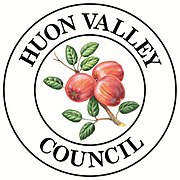world.wikisort.org - Australia
Huon Valley Council is a local government body in Tasmania, covering most of the south of the state. Huon Valley is classified as a rural local government area and has a population of 17,219,[1] towns and localities of the region include Cygnet, Dover, Franklin, Geeveston, Southport and the largest principal town, Huonville.
| Huon Valley Council Tasmania | |||||||||||||||
|---|---|---|---|---|---|---|---|---|---|---|---|---|---|---|---|
 Map showing the Huon Valley local government area with the exception of Macquarie Island. | |||||||||||||||
| Coordinates | 43.2546°S 146.5895°E | ||||||||||||||
| Population | 17,219 (2018)[1] | ||||||||||||||
| • Density | 3.1267/km2 (8.0982/sq mi) | ||||||||||||||
| Established | 2 April 1993 | ||||||||||||||
| Area | 5,507 km2 (2,126.3 sq mi)[1] | ||||||||||||||
| Mayor | Bec Enders[2] | ||||||||||||||
| Council seat | Huonville | ||||||||||||||
| Region | Huonville, Huon Valley, and Macquarie Island | ||||||||||||||
| State electorate(s) | Franklin | ||||||||||||||
| Federal division(s) | Franklin | ||||||||||||||
 | |||||||||||||||
| Website | Huon Valley Council | ||||||||||||||
| |||||||||||||||

History and attributes
In 1993 the municipalities of Esperance, Huon and Port Cygnet were amalgamated to form the Huon Valley Council.[3] Remote subantarctic Macquarie Island, which is located some 1400 km southeast of Tasmania proper, was part of Esperance until then, and has been administratively part of the Huon Valley since then.
Demographics
Huon Valley is classified as rural, agricultural and very large (RAV) under the Australian Classification of Local Governments.[4]
The townships in the south east region of Tasmania that experienced the largest growth over the decade ending June 2011 were Huonville, Franklin (where the population was up by 1,300 people) and Cygnet (up by 440).[5]
Localities
- Abels Bay
- Bishop and Clerk Islets
- Brooks Bay
- Cairns Bay
- Castle Forbes Bay
- Charlotte Cove
- Crabtree
- Cradoc
- Cygnet
- Deep Bay
- Dover
- Eggs and Bacon Bay
- Franklin
- Garden Island Creek
- Gardners Bay
- Geeveston
- Glaziers Bay
- Glen Huon
- Glendevie
- Grove
- Hastings
- Huonville
- Ida Bay
- Judbury
- Lonnavale
- Lower Longley
- Lower Wattle Grove
- Lucaston
- Lune River
- Lymington
- Macquarie Island
- Mountain River
- Nicholls Rivulet
- Pelverata
- Petcheys Bay
- Police Point
- Port Huon
- Raminea
- Randalls Bay
- Ranelagh
- Recherche
- Southport
- Southport Lagoon
- Southwest
- Strathblane
- Surges Bay
- Surveyors Bay
- Upper Woodstock
- Verona Sands
- Waterloo
- Wattle Grove
- Woodstock
Elections
The Huon Valley Council is composed of nine Councillors elected using the Hare-Clark system of proportional representation as a single ward. All Councillors are elected for a fixed four-year term of office. The Mayor and Deputy Mayor are each directly elected for a four-year term. The Mayor and Deputy Mayor must also be elected as Councillors to hold office. Elections are normally held in October, with the next election due to be held in October 2022.[6] Neither the Labor Party nor the Liberal Party endorse local government candidates in Tasmania.
In 2016 the entire Huon Valley Council was sacked by the state government after a long period of severe dysfunction.[7][8] and the municipality was controlled by a Commissioner, former Glenorchy mayor and Elwick MLC Adriana Taylor,[9] until new elections were held over a three-week period concluding on 30 October 2018.[10]
As elected in 2018 the Council had 9 members:[10]
| Councillor | Party | Notes | |
|---|---|---|---|
| Bec Enders | Independent | Mayor | |
| Mick Newell | Independent | ||
| Sally Doyle | Independent | Deputy Mayor | |
| Paul Gibson | Tasmanian Greens | ||
| Mike Wilson | Independent | ||
| Robert Prince | Independent | ||
| Juarne Bird | Independent | ||
| Mark O'May | Independent | ||
| Christine Campbell | Tasmanian Greens | ||
See also
- List of local government areas of Tasmania
References
- "3218.0 – Regional Population Growth, Australia, 2017-18: Population Estimates by Local Government Area (ASGS 2018), 2017 to 2018". Australian Bureau of Statistics. Australian Bureau of Statistics. 27 March 2019. Retrieved 25 October 2019. Estimated resident population, 30 June 2018.
- "Local council polls: Sue Hickey elected Hobart Lord Mayor over Damon Thomas". Australian Broadcasting Corporation. 29 October 2014. Retrieved 1 August 2021.
- "Agency Details: Huon Valley Council". search.archives.tas.gov.au. Tasmanian Government. Retrieved 11 June 2018.
- "Local government national report 2014-2015". regional.gov.au. Australian Government. Retrieved 8 June 2018.
- "3218.0 – Regional Population Growth, Australia, 2011". Tasmania, State Summary. Australian Bureau of Statistics. 31 July 2012. Retrieved 31 July 2015.
- "Council elections". Your council. Huon Valley Council. Retrieved 31 July 2015.
- "Huon Valley Council dismissed". The Mercury. 6 October 2016.
- "Peter Gutwein formally sacks Huon Valley Council". ABC News. 6 October 2016.
- "Huon's interim boss won't talk mergers". The Mercury. 7 October 2016.
- "Huon Valley Council Progressive Results". Local Government Elections 2018. Tasmanian Electoral Commission. 2018. Retrieved 1 August 2021.
Further reading
- Tyson, Nell. and Rushton, Annie (1995) Family bushwalks in Tasmania's Huon valley Dover, Tas.: Driftwood Publishing. ISBN 0-646-26155-X
External links
- Huon Valley Council official website
- Local Government Association Tasmania
- Tasmanian Electoral Commission - local government
Другой контент может иметь иную лицензию. Перед использованием материалов сайта WikiSort.org внимательно изучите правила лицензирования конкретных элементов наполнения сайта.
WikiSort.org - проект по пересортировке и дополнению контента Википедии